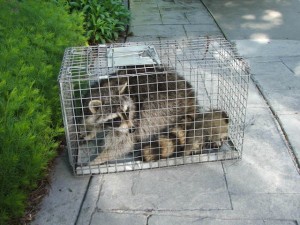Catching Raccoons
 Why would you really want to catch raccoons? Catching raccoons can be a dangerous messy business. Let’s assume that you use a live animal trap and you were successful in luring an adult raccoon into the live animal trap. This is actually pretty difficult since they are very intelligent animals and know enough to stay out of these traps.
Why would you really want to catch raccoons? Catching raccoons can be a dangerous messy business. Let’s assume that you use a live animal trap and you were successful in luring an adult raccoon into the live animal trap. This is actually pretty difficult since they are very intelligent animals and know enough to stay out of these traps.
Now you have a very upset raccoon that weighs between 20 and 40 pounds. This raccoon is snarling, biting, and clawing at anything that comes close. He is desperately trying to get out of the trap and he’s scared. Everyone knows that a trapped animal will fight for his life. Even a rabbit will snarl and hiss and claw if it is cornered.
Raccoons can be Dangerous
Raccoons are much more dangerous than rabbits! They have sharp teeth, and sharp claws that can do a lot of damage if you place your hands too close to the live animal trap. Even just the act of picking up the trap using the carrying handle might be enough to get scratched badly. They have a lot of diseases and infections can transfer very easily. Many raccoons may be infected with rabies. Rabies can be given to humans causing serious consequences for anyone bitten by a rabid raccoon.
What is the best way to deal with raccoons?
As it turns out you do not want to catch raccoons at all. The best way to deal with raccoons that are in your attic is to install a one-way trapdoor. They can get out of the den but not back in. Install heavy gauge wire mesh over all other potential entrances. Even if they get out of the den through the one-way trapdoor they cannot find another way to get back into the den.
You also must make sure that the babies, if there are babies, are able to travel on their own. They need to get out of the one-way trapdoor. If the raccoon babies are left inside the den with no access by the parents, the parents have been known to literally tear the roof apart or tear a building apart in order to rescue their young. They are very loyal parents and will do anything to get to the babies who by this time will be crying for their parents.
Consumers with this problem really have two choices. One is to wait until the babies are old enough to travel on their own and have been observed outside the den. At this point, you can safely install a one-way trapdoor and know that the raccoon babies will be able to exit with no problem. The second approach is to install a one-way trapdoor and make sure that the adults have left the den. At this point, you can go inside the den, pick up the babies and take them outside and give them to the adults. If you do take this approach make sure that you wear adequate breathing protection to avoid ingesting any bacteria that could be floating in the air.
Safety Concerns when Catching Raccoons
Make sure that you disinfect all of your clothing. Take a shower after having left the den to avoid the transfer of infection from the raccoons to yourself. Leaving the babies to die inside the den is not an option. If the raccoon parents do not rescue them while ruining your roof etc., then you will have a very bad smell from the rotting carcasses of the baby raccoons. This is certainly not pleasant and could ruin your house.
Hopefully, you’ve understood that catching raccoons is not a satisfactory approach. They’re much simpler, better, and long-term solutions to catching raccoons. Installing a one-way is a permanent solution to keep raccoons and other animals out of your house and other buildings.
You can follow any responses to this entry through the RSS 2.0 feed. You can leave a response, or trackback from your own site.

Leave a Reply